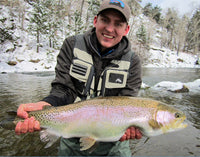
Tips & Tactics for Fly Fishing Winter Tailwaters
Tailwaters can be most simply defined as the waters immediately downstream of a hydraulic structure, such as a dam or culvert. For those of us that don't consider 8 - 9 months of beautiful sunny weather as sufficient to satisfy our urge to fish, tailwaters offer some excellent winter action! The Blue River below Dillon Reservoir, the Frying Pan River below Ruedi Reservoir, and the Taylor River below the dam are legendary for the size and vigor of their trout. Before we get into how to fish for these winter tailwater monsters, let's discuss why these waters are so productive and offer such consistent action.
The health and dynamic nature of tailwaters are intimately connected to the reservoirs above them. Lakes and reservoirs are the beneficiaries of nutrients and food drawn from the entire watershed and region. Rivers, creeks, and drainages around the lake feed a steady supply of nutrient-rich soil, leaves, and woody material into the basin which are eagerly consumed by aquatic invertebrates. These large chironomids, mysis shrimp, and scud are like bacon cheeseburgers to trout! Keeping with the fast food analogy, the dam acts like a drive-through window out of which these protein-rich invertebrates are poured into the tailwater and the waiting mouths of trout. It is the combination of food coming out of the reservoirs and those emerging from the river that create these tailwater monsters of our dreams.
Each fall, as the mercury begins to drop, reservoir waters cool and undergo the process of turnover. During turnover, the water within the reservoir flips, with a layer of cooler water forming along the surface while warmer water settles in a layer along the bottom of the reservoir. The majority of dams above trophy tailwaters release water from the bottom of the reservoir, which is the second key to the productivity and consistency of these fisheries. In addition to keeping ice from forming for miles below the dam, the unseasonably warm water pouring from the reservoir creates quite the stir among the river invertebrates. Many invertebrates within the river (particularly midges and a few small mayfly species) are prompted by the warm water to begin their emergence. It is not uncommon to see modest midge hatches on a sunny February afternoon, or even a few blue wing olives working to rise from the water with snow still covering the banks. While the cool air temperatures make these emergences short-lived, the ability to fish a dry in the winter is a rare treat, and worth a trip to the nearest tailwater!
Winter tailwater fishing is dominated by midges. While there are still a few resident stonefly nymphs and small mayfly nymphs present, midge larva, pupa, and emergers from sizes 20 - 26 are going to be your best bet. Fish under an indicator with BB type split shots to bring these small offerings into the tight feeding lanes of the lethargic winter trout. Black, grey, and wine colored flies with a little flash from bead, wire, or backing will help to make your fly stand out from the naturals and seduce the strike. Be safe on the water and I hope to see you on the tailwaters this winter!



